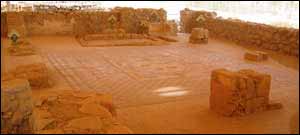 | |
| Incredible beauty makes Ein Gedi real phenomenon | |
THE juxtaposition of water and desert has always fascinated me. The contrast between the brown landscape and the cool blue pools of water that are hidden in the canyons is unique, and the Judean Desert is one of the few spots where this phenomenon can be experienced.
One of the best places to engage in this kind of experience is Ein Gedi. Every time I visit Ein Gedi, I’m renewed with a burst of energy as I delight in the natural desert surroundings. The desert is such a peaceful place, and the discovery of a water source is always extremely exciting and refreshing. There are two perennial streams that flow through the Ein Gedi Nature Reserve: Nahal David, in the north, and Nahal Arugot, in the southern part of the reserve. These two streams essentially bisect the nature reserve and provide hikers with two separate entry spots. But there’s much more than just these two streams in the Ein Gedi Nature Reserve. There are also archaeological gems that are worth investigating, such as the temple from the Chalcolithic period, as well as a number of indigenous animals, such as rock hyrax and ibex that leap around the canyons unhindered, and wolves and hyenas, which come out only after dark. In addition, visitors can see desert plants such as acacia trees, reeds and the famous Christ’s thorn jujube. As you make your way to waterfalls and pools, you might be lucky enough to be welcomed by an ibex or two. The pools are filled by water that flows from four different springs: Ein Gedi, Ma’ayan David, Arugot and Shulamit. When you enter the nature reserve from the Nahal David parking area, you can pick which route you’d like to take. Some routes are easy walks, whereas others are more suitable for hikers accustomed to more challenging treks. What’s special about Ein Gedi is that even if you choose the shortest option, you’ll still reach one of the pools, waterfalls and ancient aqueducts that have been preserved, remnants of ancient Jewish settlements. The Lower Nahal David trail, which is a short path, is perfect for families with small children. It begins at the Nahal David parking area. The trail markers make the navigation extremely straightforward and the entire hike takes just one hour. Another option is the medium-difficulty path, which is also quite popular among visitors. This linear route begins at the Arugot parking area and takes about three hours in all. The trail leads to the lower part of Nahal Arugot and hikers on this path will enjoy a visit to a wonderful hidden waterfall. The trail markers make it very clear how to reach the waterfall, and you can wade in the water of the pool. If you desire, you can hike one more kilometre to the Arugot upper pools, which are even more fun to swim in. When you’ve finished, just retrace your steps back to the entrance. It’s best to start out early in the morning on this path so that you have ample time to relax and enjoy yourselves at the pools. There’s a third trail that’s geared to experienced hikers. The trail begins in the Lower Nahal David and reaches the David Waterfall. There are plenty of pools to cool off in along the way, so you can go at any pace you like. Even with all the rest stops, this path isn’t meant to take more than six hours. Because it’s a linear trail, which begins at Nahal David and ends at Nahal Arugot, you need to pay attention to the time and also leave a car at each end. Once you reach David Waterfall, continue along the path that leads to Ma’ayan Shulamit. From there, walk toward the Dudim Cave, which is made of limestone, and which is situated just next to the waterfall. From there, continue to the Chalcolithic temple, from which there’s an amazing view of the Judean Desert and the Dead Sea. Next, you’ll reach the Ein Gedi Spring, which is near the remains of an ancient flour mill. The path continues descending toward Nahal Arugot and the hidden waterfall, which you see only at the very last second. To reach the waterfall, follow the red trail markers until you find the entrance, which is somewhat hidden in the thick vegetation. Cooling off in the refreshing pool water is one of the best parts of the entire hike. When you’ve rested, continue walking toward the entrance of Nahal Arugot. If you have any energy left after your hike, I highly recommend making a short stop at the ancient synagogue, which is just a five-minute drive from Kibbutz Ein Gedi and located inside the Ein Gedi Antiquities National Park. These ruins were uncovered during archaeological excavations that were carried out in the 1970s. Archaeologists date the synagogue back to the Byzantine period, and apparently it was in use for about 400 years, until it was completely destroyed in a fire. The discovery of a synagogue there proves that there was an active Jewish community in this area. The synagogue was most likely very well-funded, since an impressive mosaic floor was uncovered inside that includes sentences in ancient Hebrew and Aramaic. A seven-branch menorah made out of bronze and ancient coins were also found on the site.
If you have a story or an issue you want us to cover, let us know - in complete confidence - by contacting newsdesk@jewishtelegraph.com, 0161-741 2631 or via Facebook / Twitter
|
 EXCAVATION: The ancient synagogue at Ein Gedi
EXCAVATION: The ancient synagogue at Ein Gedi